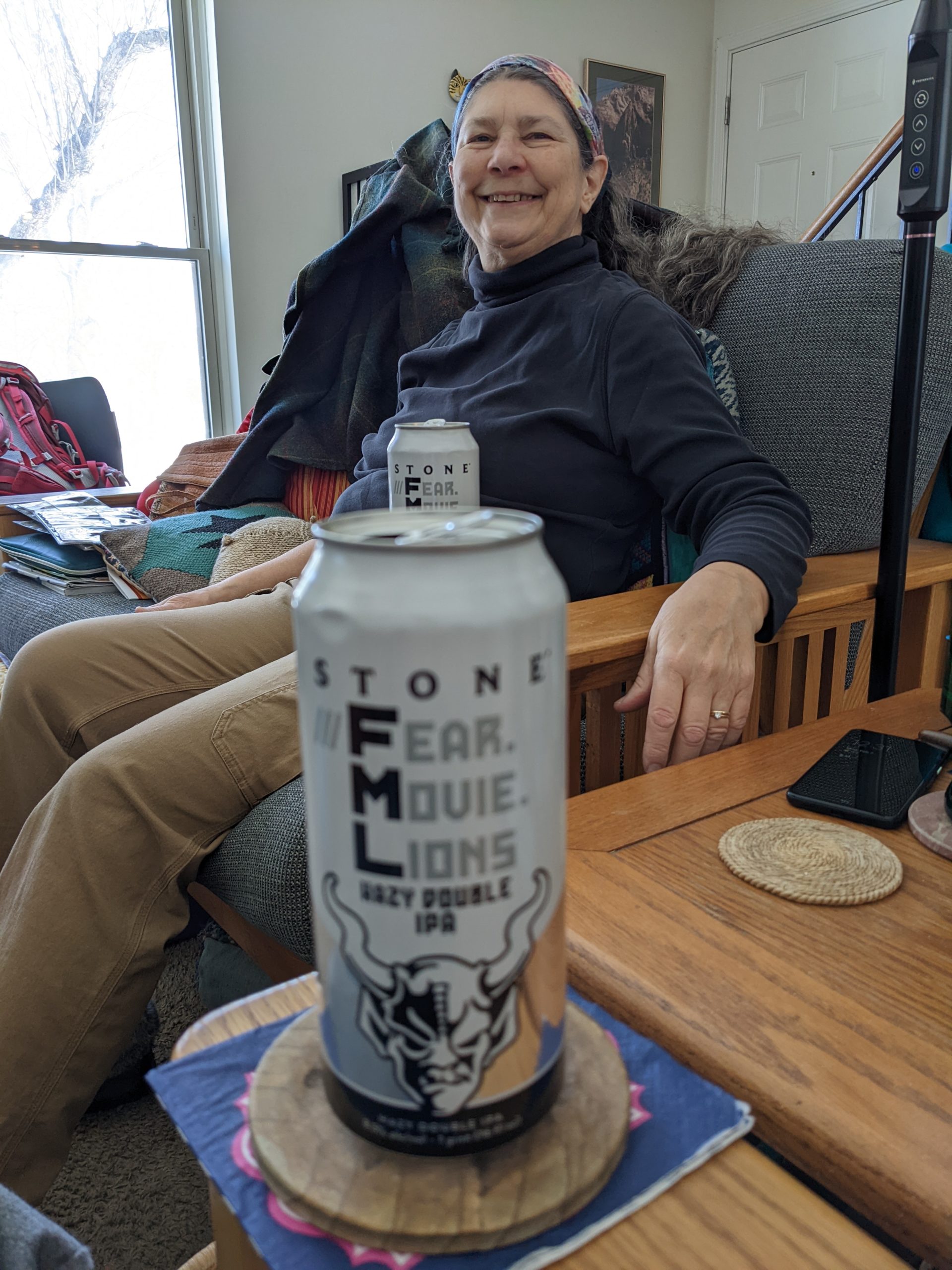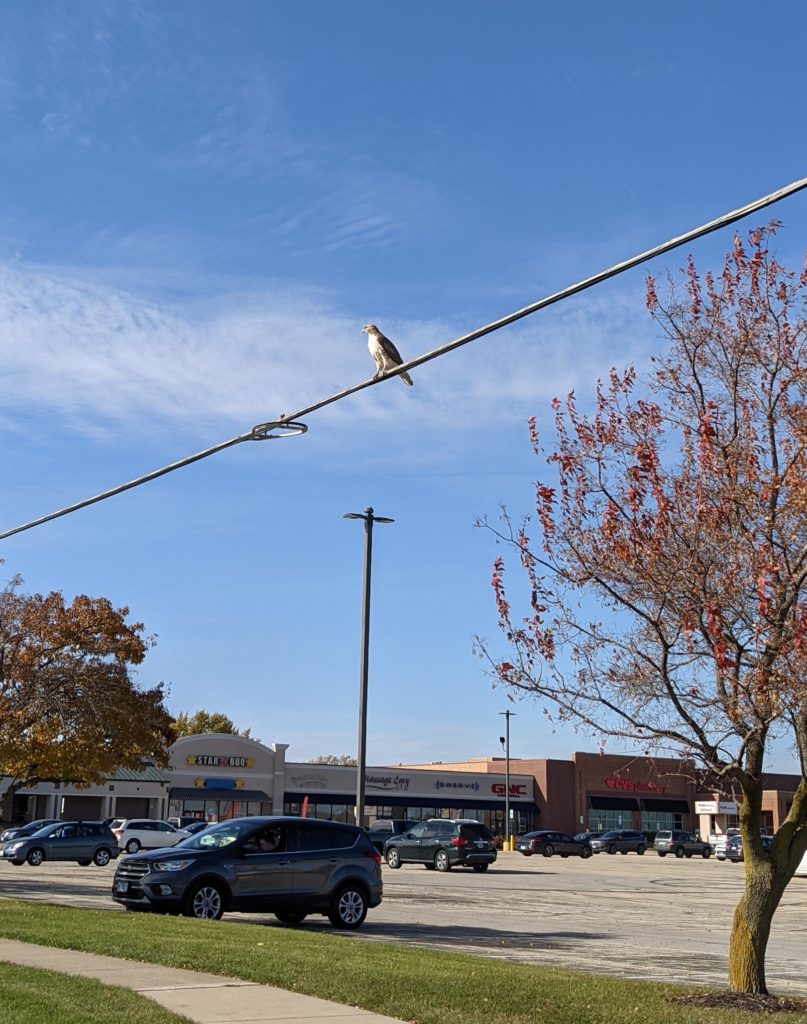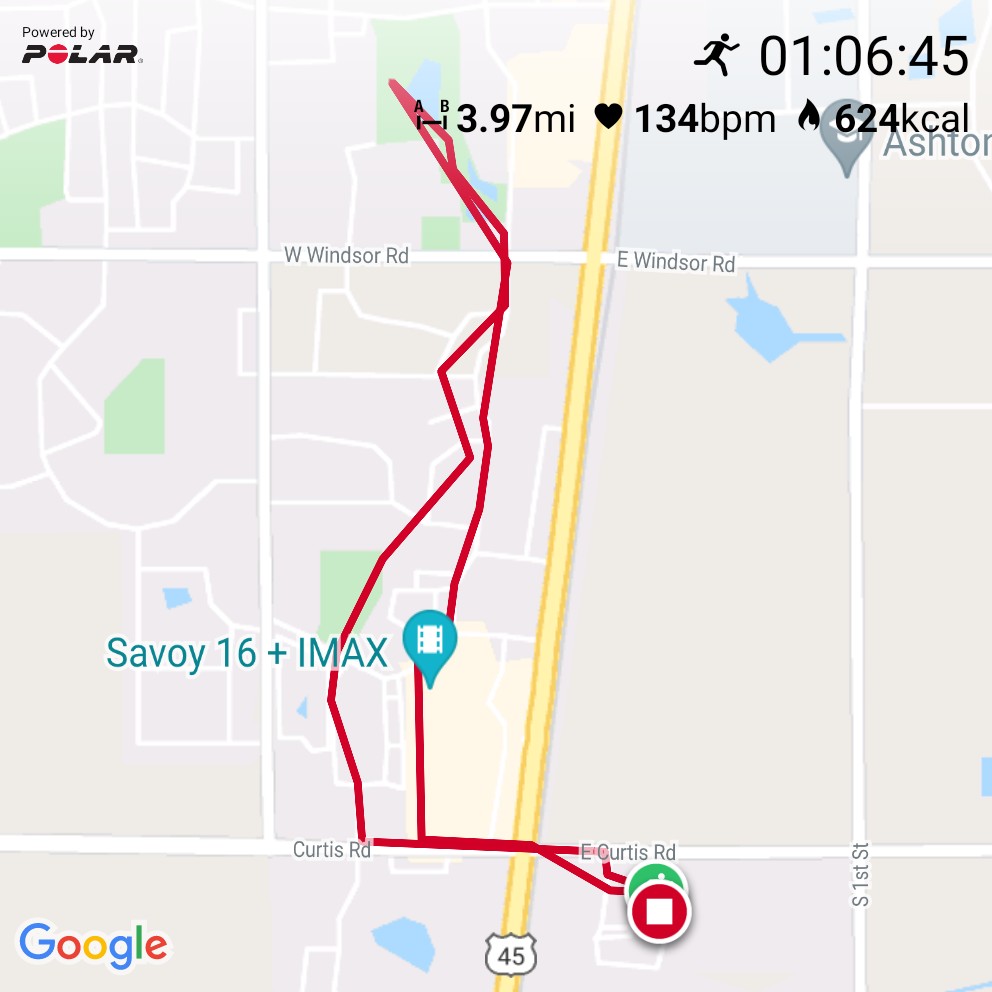I’ve been drinking almost exclusively local beers for more than a year now, but I have very fond memories of Stone’s Fear Movie Lions.


I’ve been drinking almost exclusively local beers for more than a year now, but I have very fond memories of Stone’s Fear Movie Lions.


It’s a bit harder to put this past year in a tidy descriptive box than it has been the past few years. Probably the simplest description would be: The same, but less so.
Last year I did a great job of leaning into exercise as a way to cope with the pandemic. This year started with me feeling like I could imagine that the pandemic would end, and I was focusing of all the new things I could do, once I could spend time with other people—rock climbing, parkour, fencing, historical European martial arts (i.e. sword fighting), etc.
Except then the pandemic didn’t end, and I was left to carry on as best I could with last year’s exercises. I did okay, but not as well as I had done.
In fact, I’m perfectly pleased with the way I maintained my capabilities. Late last year I checked and documented that I’d pretty much accomplished the baseline goals that I’d set for myself (see Five years of parkour strength training). I just checked again, and I’ve not backslid on those.
Last year I didn’t even think about setting new baseline goals, because my plan had been to move on from these solo training goals to training with other actual people. This year I’ve felt like I needed to at least think about it, but so far I’m not feeling it. I do want to recover the ability to do a few pull ups (again!), but that’s about the only physical benchmark of that sort where I feel like I want or need specific improvement.
It’s not that I’m a perfect physical specimen; it’s just that I don’t have much attachment to being able to squat this much weight or deadlift that much. I want to be strong enough to pick up something heavy and carry it a reasonable distance, but I don’t feel much need to put specific numbers on that weight or that distance.
I wrote a day or two ago about how I gradually shifted to more running and less lifting, which has been great. But in the middle of the year I spent some months doing less of everything—I had a minor medical issue in the spring, then we took a vacation, then I went to visit my dad, then Jackie had her hip replacement (meaning that I had to pretty much take over running the household for a few weeks). I did okay in terms of not backsliding too much, but I didn’t make much forward progress, and it has only been in the last six weeks or so that I’m really getting back to doing what I want to do.
So, where to go from here? I guess I want to:
I’ll aim to do something just like that in January and February. Along about March or April I will want to do the Superhero workout that I couldn’t do last year—that’ll be a brief interruption in my shift back to more running and less lifting, but just for eight or nine weeks. In mid-summer we have a plan for a hiking vacation in North Carolina, so in May and June we’ll want to gradually boost the amount and speed of our walks, and be sure to include plenty of hikes on trails, and to get in as much elevation change as possible in Central Illinois. I’ve got a couple more trips planned for late summer (assuming the pandemic allows), including attending WorldCon, but it’s only the hiking trip that will have much influence on my movement strategy.
So, I guess I have a plan.
I hear the beating of the egg whites, and know that pancake time is approaching.

My workout was a medium-length run of 3.97 miles which I ran in 1:06:45, but that was not my only activity. Besides that, I also hiked a similar-length trail at Homer Lake with Jackie.
The walk was especially nice, and we’re very pleased that (with her new bionic hip) Jackie is once again able to walk reasonable distances. We walked about 2.72 miles in 1:24. There were some very nice views of Homer Lake, as well as some deer, some blue jays, and a handsome snek that I failed to get a decent picture of.
I did get a decent picture of Jackie:

Besides the pictures from Homer Lake, I also got a picture of a handsome Red-tailed Hawk while I was out running, taken quite close to home. (See at the top of this post.) He was still there as I returned home.
I should mention that the run was actually quite a bit longer than my exercise-tracking app gave me credit for. (Google Fit estimates the distance at 4.46 miles.)
You can get an idea of just how much my exercise-tracking app shorted me from this map, if you know that I ran around the lake at the north end of of my run (and not as the map suggests, through it), and that I generally followed roads and paths (without cutting nearly as many corners as the map suggests).

I want to reassure people that I will not be posting all of my workouts going forward. I just wanted to post a representative strength training session and run, so that I’d have then here as examples.

And here is the elusive @jackieLbrewer in her natural environment, with the handknit socks at the Spinners and Weavers Guild annual show and sale.

Both @jackieLbrewer and I are drinking Thiol Trip Tech, a double IPA I’ve not previously tried. We both like it okay.
Jackie is scheduled for a hip replacement next month. To prepare for that, her surgeon wants her to target a fairly high level of protein consumption. To be sure she’s hitting it, Jackie has been tracking her protein consumption, and as long as Jackie was doing so, it was easy for me to do so as well. The results have been kind of interesting.

I did a bit of quick research, and determined that 0.7 g of protein per pound of bodyweight (1.54 g per kg of bodyweight) was a reasonable target. I got that figure from How to Build Strong & Lean Bodyweight Muscle by Anthony Arvanitakis, but I cross-checked that with the latest scientific, evidence-based recommendations, which say:
For building muscle mass and for maintaining muscle mass through a positive muscle protein balance, an overall daily protein intake in the range of 1.4–2.0 g protein/kg body weight/day (g/kg/d) is sufficient for most exercising individuals, a value that falls in line within the Acceptable Macronutrient Distribution Range published by the Institute of Medicine for protein.
International Society of Sports Nutrition Position Stand: protein and exercise
I had not been tracking my protein previously. Instead, after I started lifting pretty seriously 18 months ago, I had simply added a protein shake with around 25 g of protein after my workouts. My thinking was something along the lines of, “I’m healthy, so I must be eating enough protein, so adding 25 g after each workout will surely add up to enough protein to build some muscle.”
I’ve been kind of frustrated for pretty much that whole 18 months that, although I increased my strength a good bit, I did not actually build any muscle to speak of. And yet, until Jackie’s surgeon suggested that she increase her protein consumption, I hadn’t gone to the trouble of tracking my own. So, I was surprised to find that I wasn’t getting as much protein as I’d assumed.
By the formula, I ought to aim to consume right around 100 g of protein.
The first day I actually did the tracking, I only ate 88 g, even though I included a 25 g protein shake and 10 g of essential amino acids from another workout beverage, a discovery that was kind of daunting. It meant that on non-workout days I was probably only consuming 55–60 g of protein. Enough for basic health (almost exactly the RDA for protein for a sedentary person of my weight), but clearly not enough to build muscle.
So, I stepped up my protein consumption.
Hitting my target generally required:
Doing that I found it easy enough to hit about 96–97 g of protein per day, although I actually only hit my 100 g target when my main meal included a larger-than-usual serving of meat or salmon.
That much food—enough to get close to 100 g of protein from actual food—ends up being really, really filling. I was probably only getting 55–60 g of protein per day from actual food. Now that I’m adding some extra peanut butter and cottage cheese, I’m probably hitting 75–80 g, but I can’t see hitting 100 without including that protein shake.
Getting a quarter of my protein from industrially produced edible substances (aka my protein shake) rather goes against my dietary rule number 1 (eat food), but I’m willing to let that rule slide with regard to a quarter of my protein as an experiment.
And as an experiment, as I say, it’s been kind of interesting.
The first interesting thing, as I’ve just described was how much I was falling short of my target, even adding a protein supplement.
The second interesting thing is how much better I’ve felt since upping my protein consumption by 15% or so. (That is, by 15% on days that I workout, when I was already drinking my protein shake. On days that I didn’t workout, and hence didn’t drink a protein shake, I wasn’t getting much more than 55–60 g of protein, so hitting 100 g on those days amounts to a 60–70% increase.)
After just a few days I noticed that I was feeling better, that I was recovering better from workouts (requiring fewer rest days), and that I seemed to be mentally sharper. Of course any of those things could be just the placebo effect, and in any case this is just an anecdotal report. But, since it is my anecdotal report, I’m taking it seriously, and am continuing to try to hit my 100 g per day.
All of which brings me to the title of this post.
If you’re familiar with bodybuilding, you’re aware that bodybuilders go through alternate phases of “bulking,” where they eat a caloric surplus to support building muscle, followed by “cutting,” where they eat a caloric deficit to lose fat and reveal the muscle they’ve built. This has always seemed unwise to me. Given my history of excess weight, I’m never going to do this on purpose. But getting 100 g of protein has proven to be quite difficult to do without eating a caloric surplus.
Because I track my weight as well, I’m able to look back over the past 19 days and see that my weight gain implies a daily surplus of 302 calories. That’s not untenable in the short term, but it’s not something I’m going to be willing to tolerate for long. It is, however, right in line with the bro-science recommendations for how to do a “clean bulk” (where you aim for just barely enough extra calories to build muscle.)
Still, it does give me an opportunity for some other experiments. My LDL cholesterol was a bit high at my recent physical, and I’m sure I could get it down by eating less fat. But since I was already limiting my carbs for other reasons, cutting fat as well would have put me into a caloric deficit. But now, with all this extra protein, maybe I can make modest cuts to my fat consumption, and bring my total calories into balance with neither excess carbs nor excess fat. In fact, I’m sure I could do that; the question is whether I can do that and still eat food (rather than industrially produced food-like edible substances).
I’m something of a tracker by nature, always interested in tracking and optimizing everything that I do. But even for me this seems rather a lot. I don’t think I can face actually trying to get the math right, to hit my protein target, keep my carbs low, and cut my fat enough to bring my calorie consumption in at a level that maintains my weight where I want it to be, all while eating food.
Currently I’m hoping that, if I keep eating lots of protein, and then try to limit my fats just a bit, I’ll get lucky and it’ll all just work out.
I’ll keep you posted.
Hanging in the shade with my sweetie.

Both @jackieLbrewer and I drinking the Cigar City Jai Alai that I had at Bilbo’s last month. Glad to get a chance for Jackie to try it. @sevensaints
